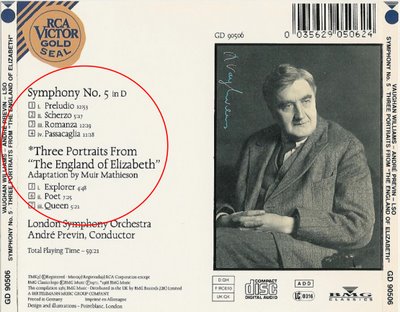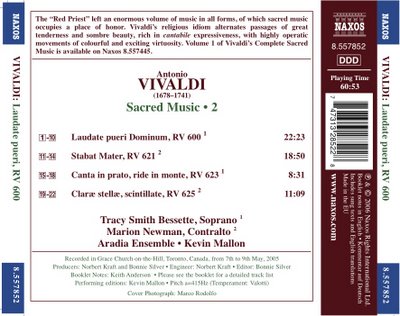Introduction to classical music #5: CD jackets.
I won't teach you anything new by saying that in the majority of record stores, classical music sections are based on an alphabetical system for browsing, with sub-sections for each type of music, like Symphonies, Concertos, Vocals, etc. But when you are looking for a precise recording, how can you decode all that often obscure information found on CD jackets? I would say that, in some way, CD jackets give too much information, it is simply a matter of retaining what you really need.
As a demonstration, I will examine with you the CD jacket of a recording of Vaughan Willams' 5th symphony; I will in fact examine the back of the CD jacket, since all essential information is normally found there.
Titles:

I circled in red the title of the two pieces of this recording, since the name of the composer can be found on the front jacket; note that since the advent of the CD, most of the classical music recordings offer, in addition to the principal composition, one or two more pices, like at a concert.
Interpreters:

I circled in red the name of the conductor as well as the name of the orchestra, which is usually found under the titles; if the recording is a piece with a choral or an instrumentalist for example, information relating to this matter should be found at the same place. If it is a live recording, it should also be noted here.
So we have here all the essential information, which should be normally sufficient to ensure that you found exactly what you were looking for.
But you could also have additional information at hand, for example the date of the recording, which is generally found at the bottom of the jacket (or on the side), along with the details relating to the label and copyright of the recording, as I circled in red here, at the bottom left:

The date can be important, because it hapens sometimes that the same conductor will record more than once the same piece, with the same orchestra. I also circled the technical information of the recording (at the bottom on the right), the ADD meaning that this is a remastered analog recording. I underlined this detail because many people refuse to buy recordings which are not digital, in DDD, but we will talk about this another time.
As for the other elements of the jackets, like the photography of the composer or the durations of the recordings, they are more or less useful details. As for the label of the recording, in this case RCA Victor, we will talk about it in the next entry if this blog.
I'll let to you examine here the back of another CD jacket:

Here, under the titles,you have information about the interpreters, which indicates that this is a volca piece, if the titles by themselves meant nothing to you. The type and the year of the recording are found here on the right side of the jacket.
So you see, it is very simple!
Before I finish, I cannot overlook the fact that the majority of the classical CD jackets suffer from a serious illness, that of the doubtful and cliché designs. In fact, I would say that there are three great types of jackets in classical music:
1) the jacket with the indentity card style, where you normally see a photograph of the conductor or of the interpreter, like those two small gems:


2) the jacket with the first degree illustration style, where you can see an image that is directly related to the recorded piece; I'm thinking here about all those classical CD jackets with nature paintings and images of clouds or any other kind of image that tries to illustrate the meaning of the recorded piece. But the world champion of this kind of jacket is undoubtedly The Planets by Holst, as shown in it these fine examples:



3) the jacket with the schizophrenic style, where the image has absolutely nothing to do with the recorded piece or with the interpreters, as found on those rather imaginative jackets (the one with a building is a recording of a symphony by Thcaikovsky...):


I think it is sad that classical music labels do not seem to want to produce more attractive and original CD jackets; these bad designs contribute, in my opinion, to give to classical music an old fashionned image, which can scare away a much younger group of customers…
So I wish you some good in-store browsing, and don't forget that most of used CD stores are gold mine for good and cheap classical recordings.
Next time, I will talk to you about the classical music labels.
Ciao!
As a demonstration, I will examine with you the CD jacket of a recording of Vaughan Willams' 5th symphony; I will in fact examine the back of the CD jacket, since all essential information is normally found there.
Titles:

I circled in red the title of the two pieces of this recording, since the name of the composer can be found on the front jacket; note that since the advent of the CD, most of the classical music recordings offer, in addition to the principal composition, one or two more pices, like at a concert.
Interpreters:

I circled in red the name of the conductor as well as the name of the orchestra, which is usually found under the titles; if the recording is a piece with a choral or an instrumentalist for example, information relating to this matter should be found at the same place. If it is a live recording, it should also be noted here.
So we have here all the essential information, which should be normally sufficient to ensure that you found exactly what you were looking for.
But you could also have additional information at hand, for example the date of the recording, which is generally found at the bottom of the jacket (or on the side), along with the details relating to the label and copyright of the recording, as I circled in red here, at the bottom left:

The date can be important, because it hapens sometimes that the same conductor will record more than once the same piece, with the same orchestra. I also circled the technical information of the recording (at the bottom on the right), the ADD meaning that this is a remastered analog recording. I underlined this detail because many people refuse to buy recordings which are not digital, in DDD, but we will talk about this another time.
As for the other elements of the jackets, like the photography of the composer or the durations of the recordings, they are more or less useful details. As for the label of the recording, in this case RCA Victor, we will talk about it in the next entry if this blog.
I'll let to you examine here the back of another CD jacket:

Here, under the titles,you have information about the interpreters, which indicates that this is a volca piece, if the titles by themselves meant nothing to you. The type and the year of the recording are found here on the right side of the jacket.
So you see, it is very simple!
Before I finish, I cannot overlook the fact that the majority of the classical CD jackets suffer from a serious illness, that of the doubtful and cliché designs. In fact, I would say that there are three great types of jackets in classical music:
1) the jacket with the indentity card style, where you normally see a photograph of the conductor or of the interpreter, like those two small gems:


2) the jacket with the first degree illustration style, where you can see an image that is directly related to the recorded piece; I'm thinking here about all those classical CD jackets with nature paintings and images of clouds or any other kind of image that tries to illustrate the meaning of the recorded piece. But the world champion of this kind of jacket is undoubtedly The Planets by Holst, as shown in it these fine examples:



3) the jacket with the schizophrenic style, where the image has absolutely nothing to do with the recorded piece or with the interpreters, as found on those rather imaginative jackets (the one with a building is a recording of a symphony by Thcaikovsky...):


I think it is sad that classical music labels do not seem to want to produce more attractive and original CD jackets; these bad designs contribute, in my opinion, to give to classical music an old fashionned image, which can scare away a much younger group of customers…
So I wish you some good in-store browsing, and don't forget that most of used CD stores are gold mine for good and cheap classical recordings.
Next time, I will talk to you about the classical music labels.
Ciao!


0 Comments:
Post a Comment
<< Home